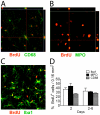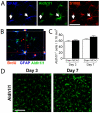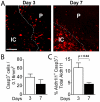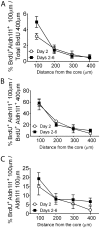Astrocyte proliferation following stroke in the mouse depends on distance from the infarct
- PMID: 22132159
- PMCID: PMC3221692
- DOI: 10.1371/journal.pone.0027881
Astrocyte proliferation following stroke in the mouse depends on distance from the infarct
Abstract
Reactive gliosis is a hallmark of brain pathology and the injury response, yet the extent to which astrocytes proliferate, and whether this is central to astrogliosis is still controversial. We determined the fraction of mature astrocytes that proliferate in a mouse stroke model using unbiased stereology as a function of distance from the infarct edge. Cumulatively 11.1±1.2% of Aldh1l1(+) astrocytes within 400 µm in the cortical penumbra incorporate BrdU in the first week following stroke, while the overall number of astrocytes does not change. The number of astrocytes proliferating fell sharply with distance with more than half of all proliferating astrocytes found within 100 µm of the edge of the infarct. Despite extensive cell proliferation primarily of microglia and neutrophils/monocytes in the week following stroke, few mature astrocytes re-enter cell cycle, and these are concentrated close to the infarct boundary.
Conflict of interest statement
Figures





References
-
- Pekny M, Nilsson M. Astrocyte activation and reactive gliosis. Glia. 2005;50:427–434. - PubMed
Publication types
MeSH terms
Substances
Grants and funding
LinkOut - more resources
Full Text Sources
Molecular Biology Databases

